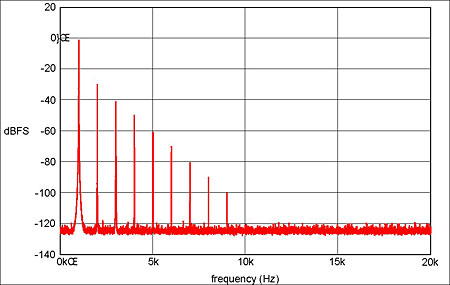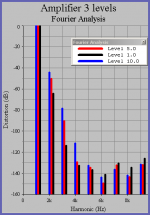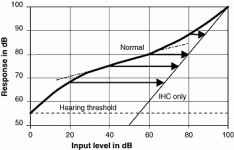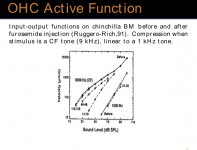A lot of people I know who have strong views on 'amplifier sound' prefer amps with some sort of audible distortion. Amps that have audible distortion are the only ones that can alter the perceived spectral balance of a playback system.
This is not my strategy for getting good sound as you can alter the perceived spectral balance by subtle EQ without the penalty of added distortion, which if bad, turns good recordings of complex material into mush.
This is not my strategy for getting good sound as you can alter the perceived spectral balance by subtle EQ without the penalty of added distortion, which if bad, turns good recordings of complex material into mush.
darian,
the middle ear is linear. You won`t be helped by listening to people disseminating heresies and can unlikely come up with a different, well-substantiated explanation, bearing in mind how much effort and time this exploration took. You should accept it, that`s what we have got at the moment.
the middle ear is linear. You won`t be helped by listening to people disseminating heresies and can unlikely come up with a different, well-substantiated explanation, bearing in mind how much effort and time this exploration took. You should accept it, that`s what we have got at the moment.
lineup said:...
Hiraga maybe, you say, suggested we would try to get a succesively decreasing of dist by order.
Would be interesting to see if he wrote about this.
Here is a link that quotes some more about him:
http://stereophile.com/reference/406howard/
I think audio express reprinted one of his articles a
few years back as well.
I happen to agree with his view. But I differ with him
when you can make harmonic distortion vanishingly small.
I think the quality of distortion also becomes unimportant
when you can reach very very low levels of distortion in a
system.
Mike
Mike,
Even if you are not aware of what is happening, you should instinctively feel that it`s not possible. The laws of physics would never allow that. Wake up!
Do you really believe that you can do it unpunished?But I differ with him when you can make harmonic distortion vanishingly small.
Even if you are not aware of what is happening, you should instinctively feel that it`s not possible. The laws of physics would never allow that. Wake up!
Lumba Ogir said:Mike,
Do you really believe that you can do it unpunished?
Even if you are not aware of what is happening, you should instinctively feel that it`s not possible. The laws of physics would never allow that. Wake up!
I liken it to the relationship between Newtons laws and
Einstein laws. Both explain the same phenomena, but you
can ignore Einstein unless you are working at the limits.
So Newton is to Hiraga as Einstein is to the vanishingly small.
The distortion products being looked at in the other
(hi-loop gain) thread for a 45v peak signal are around
8-24 uVolts. The wire connecting the speaker to the amp
picks up more RF/Mains grunge than that.
I think I'm awake?
Mike
lineup said:
Hiraga maybe, you say, suggested we would try to get a succesively decreasing of dist by order.
Would be interesting to see if he wrote about this.
mfc said:
Here is a link that quotes some more about him:
http://stereophile.com/reference/406howard/
I think audio express reprinted one of his articles a few years back as well.
I happen to agree with his view. But I differ with him when you can make harmonic distortion vanishingly small. I think the quality of distortion also becomes unimportant when you can reach very very low levels of distortion in a system.
mfc
As already described,
it has long been known that THD is a poor indicator
of nonlinear distortion's subjective impact,
and so it proved once again here.
-----------
Exactly what my subject & this topic is about!
And *[1] Earl Geddes was the one that got me, Lineup, to start thinking about this.
This is the Hiraga Pattern.
With falling levels by harmonics order:

-------------------------
*[1] Footnote 1:
Earl Geddes and Lidia Lee,
"Auditory Perception of Nonlinear Distortion—Theory,"
Preprint 5890, AES 115th Convention, October 2003.
All this discussion about distortion in an amp under normal
conditions..
I have been exploring the distortions (harmonics) produced
by mild to "gross" clipping on simulated and real amps.
Often wondered what all those "extra" compensations and
diodes were for in many commercial designs. We all
sometimes overdrive our amps in the persuit of "realism"
so these distortions are indeed relevant.
Saturation seems to produce the nastiest (H3,5,7 and beyond),
as many manufacturers seem to employ diode/RC schemes to
minimize this. Looking at my schema collection I have found
many techniques that are real effective at eliminating "sticking"
while reducing clipping distortion to mainly H2.
OS
conditions..
I have been exploring the distortions (harmonics) produced
by mild to "gross" clipping on simulated and real amps.

Often wondered what all those "extra" compensations and
diodes were for in many commercial designs. We all
sometimes overdrive our amps in the persuit of "realism"
so these distortions are indeed relevant.
Saturation seems to produce the nastiest (H3,5,7 and beyond),
as many manufacturers seem to employ diode/RC schemes to
minimize this. Looking at my schema collection I have found
many techniques that are real effective at eliminating "sticking"
while reducing clipping distortion to mainly H2.
OS
I am currently investigating, testing an amplifier project at this forum.
It has been introduced not long ago.
This amplifier shows Hiraga Pattern in fourier.
- see attachment
Same amplifier at three voltage output levels: 1, 5, 10
So blue pattern is at 10 times higher output than black pattern.
Notice:
Black patter has 3rd 50 dB lower than 2nd.
Still, at output level 10 times higher, BLUE PATTERN,
the 3rd is 35 dB down
and 4th is 32 dB further down.
------------------------------------------------------------------------------
You may guess this is one TUBE Amplifier Because it could very well be ....
Because it could very well be ....
But it is not.
If this amplifier has got Global Negative Feedback?
- Yeah, right .... it has not.
.... it has not.
It has been introduced not long ago.
This amplifier shows Hiraga Pattern in fourier.
- see attachment
Same amplifier at three voltage output levels: 1, 5, 10
So blue pattern is at 10 times higher output than black pattern.
Notice:
Black patter has 3rd 50 dB lower than 2nd.
Still, at output level 10 times higher, BLUE PATTERN,
the 3rd is 35 dB down
and 4th is 32 dB further down.
------------------------------------------------------------------------------
You may guess this is one TUBE Amplifier
But it is not.
If this amplifier has got Global Negative Feedback?
- Yeah, right
Attachments
Lineup,
The 3rd order harmonic component (or any other harmonic component) should no be lower (nor higher) than required for the appointed balance.
Your presentation of this topic disturbs me greatly. Are you sure you`ve got it right?Lowest possible 3rd order harmonic distortion
The 3rd order harmonic component (or any other harmonic component) should no be lower (nor higher) than required for the appointed balance.
darian (if still in doubt),
cochlear compression is nature`s way to increase the sensitivity of human hearing. Due to inner hair cell insufficiency below 50-60 dB SPL, the outer hair cells perform an active amplification, whereby basilar membrane vibrations are boosted.
A wide range of input signal is compressed to smaller range through level-dependent amplification, maximum compression is 4:1, 2:1 for soft sounds, 1:1 at very loud sounds.
This function in detail appears to be almost inextricable. Don`t even think about trying to make an automatic gain control like that.
Normal=OHC+IHC
Une grosse différance, no?
cochlear compression is nature`s way to increase the sensitivity of human hearing. Due to inner hair cell insufficiency below 50-60 dB SPL, the outer hair cells perform an active amplification, whereby basilar membrane vibrations are boosted.
A wide range of input signal is compressed to smaller range through level-dependent amplification, maximum compression is 4:1, 2:1 for soft sounds, 1:1 at very loud sounds.
This function in detail appears to be almost inextricable. Don`t even think about trying to make an automatic gain control like that.
Normal=OHC+IHC
Une grosse différance, no?
Attachments
Mike,
I don`t agree with you on the implementation of aural harmonic envelope at all. Most harmonic component values should not be zero, not even low. Having the single-ended mode as reference, departures from that and many linearizing techniques tend to cause low order harmonic and general timbral impoverishment and incoherency. Watchfulness is necessary. Simulation may show certain functions correctly, but does not reflect the sound as you will hear it, it`s just not nearly that smart.
I don`t agree with you on the implementation of aural harmonic envelope at all. Most harmonic component values should not be zero, not even low. Having the single-ended mode as reference, departures from that and many linearizing techniques tend to cause low order harmonic and general timbral impoverishment and incoherency. Watchfulness is necessary. Simulation may show certain functions correctly, but does not reflect the sound as you will hear it, it`s just not nearly that smart.
Lumba Ogir said:Mike,
I don`t agree with you on the implementation of aural harmonic envelope at all. Most harmonic component values should not be zero, not even low. Having the single-ended mode as reference, departures from that and many linearizing techniques tend to cause low order harmonic and general timbral impoverishment and incoherency. Watchfulness is necessary. Simulation may show certain functions correctly, but does not reflect the sound as you will hear it, it`s just not nearly that smart.
Hi,
I agree with the hypothesis that the "best" distortion pattern
is one that fits the natural occurring pattern of the ear. But I
only agree that this is necessary above the perception level of
the ear.
I differ if you can get below the perception level of the
ear. If you can reduce distortion to vanishingly low levels, then
this is also the equivalent of the "best" pattern.
Similiar to seeing at night. Below certain levels, the eye just
doesn't pickup on things. Similiarly, below certain levels, the
ear will not either. At these levels there is a lot of leeway in
what the distortion pattern can look like.
Mike
Hey, there's this simple program that lets you experiment with different harmonics up to the 31st harmonic... ... ...
If you have a good sound card, anyway!
Download the .zip file below and follow the directions:
http://homepage2.nifty.com/rochet/binaries/pxtone_0912.zip
1: unzip the file into a folder of choice.
2: delete japanese.ico unles you and your computer can read japanese.
3: run ptvoice.exe. Click on the "oscillator" tab to get to the oscillator.
This set of programs is for composing electronic sounding music, developed by a japanese guy.
No viruses here, but scan anyway to prove it to yourself.
- keantoken
If you have a good sound card, anyway!
Download the .zip file below and follow the directions:
http://homepage2.nifty.com/rochet/binaries/pxtone_0912.zip
1: unzip the file into a folder of choice.
2: delete japanese.ico unles you and your computer can read japanese.
3: run ptvoice.exe. Click on the "oscillator" tab to get to the oscillator.
This set of programs is for composing electronic sounding music, developed by a japanese guy.
No viruses here, but scan anyway to prove it to yourself.
- keantoken
This brings back memories working with Yamaha's DX synths in the mid 80's .
.
I don't know if one can draw any conlusions from it, but I can't say a sound with odd order harmonics "improve" by adding even order harmonics. It just becomes more of a sawtooth, and a sawtooth sounds grainy. This supports my findings that reducing 2nd order harmonics makes the amp less grainy.
This can start a new battle. What sounds closest to a sinewave, a squarewave or a sawtooth .
.
I don't know if one can draw any conlusions from it, but I can't say a sound with odd order harmonics "improve" by adding even order harmonics. It just becomes more of a sawtooth, and a sawtooth sounds grainy. This supports my findings that reducing 2nd order harmonics makes the amp less grainy.
This can start a new battle. What sounds closest to a sinewave, a squarewave or a sawtooth
 .
.- Status
- This old topic is closed. If you want to reopen this topic, contact a moderator using the "Report Post" button.
- Home
- Amplifiers
- Solid State
- When optimizing, go for Lowest 3rd harmonics .. not THD!!



